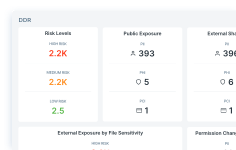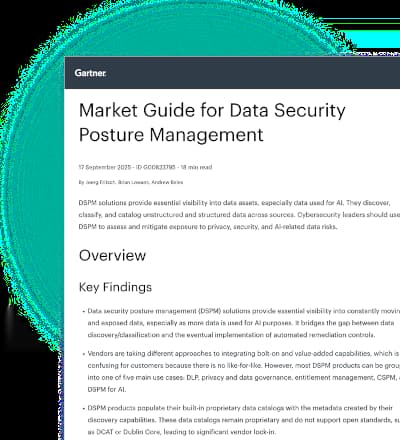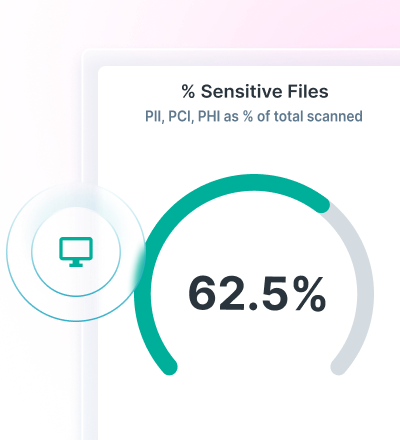Securing ChatGPT: Comprehensive Risks, Practical Safeguards & How Forcepoint Keeps Your Data Safe
0 min read

Brandon Keller
Why ChatGPT Security Matters
ChatGPT went from lab curiosity to business staple in the blink of an eye. In every function, from software development and customer support to marketing and finance, teams now use generative AI to move faster. That speed comes with a new, very real attack surface.
Every prompt can carry sensitive data. Every plugin, API call and integration can become an unguarded path for leakage or manipulation. That is why ChatGPT security has become a board-level topic.
When we talk about “ChatGPT security,” we mean the practices that protect the model, the data flowing into and out of it and the people interacting with it. Done well, it reduces the risk of data loss, model abuse, bad outcomes and non-compliance.
In this guide, we’ll break down the full risk landscape, the controls for enterprise environments and how Forcepoint’s portfolio of DSPM and DLP can help organizations use ChatGPT with confidence.
Understanding ChatGPT and Generative-AI Security
At a high level, ChatGPT is a large language model (LLM) built on transformer architectures and reinforced by human feedback. The reason it feels different from traditional software is conversation: the interface invites open-ended prompts, follow-ups and context.
That fluidity is exactly what makes ChatGPT valuable and exactly what creates new security challenges. Unstructured prompts are messy. Plugins run code. Integrations pull data from places security teams don’t always see.
Generative-AI security is therefore best viewed as a discipline within cybersecurity, focused on four things:
- Model integrity: preventing prompt injection, data poisoning, adversarial inputs and fine-tuning backdoors.
- Data protection: controlling what data goes in and comes out, ensuring confidentiality, integrity and proper retention.
- Misuse prevention: stopping attackers (or careless insiders) from using the model to generate harmful content, run exfiltration flows or skirt controls.
- Governance & compliance: aligning AI usage with frameworks, regulations and internal policies.
For security leaders, this isn’t a theoretical exercise. It’s day-to-day risk management applied to a new kind of application layer where natural language becomes an API.
Why ChatGPT Security is Essential for the Enterprise
Enterprises adopt ChatGPT to accelerate work. But without controls, a few things break fast:
- Data protection: Employees paste customer PII, source code or deal terms into a prompt. That content can leave the enterprise, be logged or appear in places it shouldn’t.
- Output reliability: Models can hallucinate. Without validation and guardrails, well-meaning teams may act on wrong answers.
- Misuse prevention: Threat actors exploit LLMs to craft convincing phishing, write polymorphic malware or automate social engineering.
- Trust: If users fear that prompts might leak, they stop using the tool, or worse, use unapproved tools in the shadows.
- Compliance: From GDPR, HIPAA and CCPA to sector requirements, AI adoption must respect data residency, minimization, retention and subject rights.
We’ve already seen how careless use can become a headline. Incidents where employees pasted confidential code into public AI services highlight the reputational and regulatory fallout when guardrails are missing.
The lesson: treat ChatGPT like any other powerful system touching sensitive data.
The Threat Landscape: Top ChatGPT Security Risks
The fastest path to strong ChatGPT security is to understand how things go wrong.
Input-Level Attacks
- Prompt injection: Attackers craft inputs that override system instructions, extract hidden context or coerce the model into unsafe behavior. These can be invisible (embedded instructions in text or even metadata) and often abuse model helpfulness.
Business impact: Leaked secrets, exfiltration of tokens or internal logic and the generation of unsafe actions or outputs.
- Data poisoning: Malicious or low-quality examples creep into training or fine-tuning sets. Even tiny proportions can skew outputs in targeted ways.
Business impact: Biased or unsafe behavior that slips past normal testing, eroding trust and compliance.
- Adversarial inputs: Carefully crafted perturbations trick the model into mistakes or harmful responses that look benign to humans.
Business impact: Decisions based on incorrect outputs, unsafe code suggestions and exposure to legal or regulatory risk.
Model-Level Threats
- Model inversion / data reconstruction: By repeatedly querying, adversaries infer sensitive elements from the model’s training data or context.
Business impact: Exposure of PII, trade secrets or proprietary datasets.
- Malicious fine-tuning or backdoors: A model fine-tuned with a poisoned dataset may behave well in general but flip into unsafe modes when triggered by special tokens or phrases.
Business impact: Hidden failure modes that bypass filters and surprise both users and defenders.
- Bias amplification and harmful outputs: Models learn from the world as it is, not as we wish it to be. Without safeguards, outputs can reflect or reinforce bias.
Business impact: Ethical and legal exposure; reputational harm.
System-Level Threats
- Privacy breaches due to memorization: Some models can regurgitate snippets of sensitive content. Combined with weak logging or retention, this puts privacy rights at risk.
Business impact: Regulatory penalties and breach notifications.
- Unauthorized account access: Compromised enterprise accounts expose chat histories, uploaded files and permissions across integrated systems.
Business impact: High-impact data loss and lateral movement across SaaS.
- Denial-of-Service: Flooding the model with complex prompts or recursive workflows degrades performance for legitimate users.
Business impact: Outages and business interruption.
- Model theft: Reverse engineering or unauthorized replication of model parameters or architecture.
Business impact: IP loss and the rise of unregulated clones that misuse your data.
- Unintentional data leakage: Seemingly harmless outputs contain confidential names, project codes or keys due to context bleed.
Business impact: Silent, cumulative exposure that’s hard to detect without content inspection.
Integration Risks
- Insecure plugins and APIs: ChatGPT’s power often depends on third-party plugins, connectors and internal APIs. If those integrations lack strong auth, encryption and isolation, they become the soft underbelly.
Business impact: Exposure during data transmission, privilege escalation and new paths for exfiltration.
Best Practices for Securing ChatGPT and Other LLMs
This is the heart of the program. The following controls map directly to the risks above and are practical to implement in large organizations.
Classify and Minimize Data Before Prompting
- Classify data at source and at the point of use. Know whether a prompt contains regulated data (PII, PHI), secrets, source code or confidential business plans.
- Anonymize wherever possible. Use masking, tokenization and synthetic substitutions so the model gets context without the crown jewels.
- Apply encryption in transit and at rest. Assume intermediaries exist; protect accordingly.
- Set retention bounds. Don’t keep prompts or outputs longer than business or legal needs require.
Where Forcepoint helps: Forcepoint Data Security Posture Management (DSPM) discovers and classifies sensitive data across cloud, network and on-premises. Forcepoint Data Loss Prevention (DLP) can monitor and block security incidents in real time wherever users interact with data.
Sanitize Inputs and Manage Prompts
- Pre-process prompts to strip suspicious instructions, hidden tokens or markup that could trigger unintended behaviors.
- Standardize prompt templates for common use-cases to reduce variability and shadow experimentation.
Where Forcepoint helps: With Forcepoint DLP, organizations can control how sensitive data is shared with ChatGPT and other generative AI platforms, allowing organizations to embrace AI transformation while preventing unauthorized data exposure and maintaining compliance.
Enforce Zero-Trust Access Controls
- Strong authentication for any enterprise ChatGPT or LLM account, including MFA and phishing-resistant methods.
- Least privilege for plugin/connector scopes; separate duties between content creators and approvers.
- Conditional access based on user, device and risk.
Where Forcepoint helps: Implement granular access controls to block risky services and guide users to approved apps.
Monitor Usage and Log for Investigation
- Centralize logs of prompts, outputs and plugin calls.
- Detect anomalies such as high-volume copy/paste into ChatGPT, repeated requests for sensitive categories or unusual access times.
- Integrate with SIEM/SOAR to correlate ChatGPT activity with broader signals (endpoint, identity, cloud).
Where Forcepoint helps: Uncover risk and get visibility of your sensitive data and its usage.
Secure API and Plugin Ecosystems
- Vet plugins for secure coding practices, patch cadence and data-handling guarantees.
- Require encrypted channels with modern TLS and mTLS where feasible; rotate tokens often.
- Constrain capabilities using allow-lists and explicit scopes; deny plugins that can reach into payment or production systems without review.
Where Forcepoint helps: Plug into ChatGPT Enterprise using APIs for granular visibility and control with Forcepoint DSPM.
Map to Frameworks and Prove Compliance
- OWASP LLM Top-10: Address injection, data leakage, supply chain and model abuse with the controls above.
- NIST AI RMF: Show you can map risk identification, measurement and mitigation to concrete policies and logs.
- Gartner AI TRiSM: Demonstrate transparency, reliability and security of AI systems across their lifecycle.
Where Forcepoint helps: Streamline regulatory compliance and access over 1,700 data classifiers, policies and templates out of the box to streamline compliance for AI applications.
The Forcepoint Approach: Visibility and Control
Forcepoint’s vision for ChatGPT security is simple: Get visibility of sensitive data and control over data usage in ChatGPT Enterprise to safeguard the use of it across the organization.
Visibility with Forcepoint DSPM
You can’t protect what you can’t see. Forcepoint DSPM helps organizations discover and classify sensitive data with AI-powered precision to proactively prioritize and remediate data risk.
Forcepoint DSPM is ideal for helping organizations do the following:
- Improve Data Visibility
- Discover and Classify with AI
- Proactively Remediate Risk
- Automate Compliance Management
Prevention with Forcepoint DLP
Forcepoint DLP helps organizations get superior visibility and control over data with out-of-the-box compliance policies for over 80 countries. Organizations can also enforce DLP policies for ChatGPT and prevent data loss with Forcepoint DLP.
Some key features to prevent data loss with Forcepoint DLP include the following:
- Utilize 1,700+ out-of-the-box classifiers to stop data loss.
- Block copy and paste of sensitive information into web browsers and cloud apps.
- Unify policy management and enforce them everywhere users access data.
- Use unified policy management to control data loss through generative AI.
Putting it Together: a Zero-Trust Data Security Platform
The real power shows up when Forcepoint DSPM and DLP work together.
Forcepoint DSPM delivers innovative data classification by improving accuracy, efficiency and reliability through its cutting-edge AI Mesh technology. Using a network of AI and data science models enables highly confident data classification at lightning-fast speeds to ensure all your data is accounted for and secure.
Paired with Forcepoint DLP, organizations can further unleash the power of AI securely via in-line blocking of sensitive data with high accuracy in generative AI applications.
Regulatory and Compliance Considerations
AI usage must respect privacy and compliance standards. Forcepoint’s controls help prevent sensitive data from leaving, enhance security for ChatGPT and help streamline regulatory compliance.
Secure the Upside of AI
ChatGPT is here so are its risks. Treat prompts like data flows. Treat plugins like third-party apps. Treat ChatGPT like a powerful system that needs safeguarding.
Learn even more about securing ChatGPT with Forcepoint HERE.

Brandon Keller
Read more articles by Brandon KellerBrandon is a Multimedia Content Marketer, driving content strategy and development across Forcepoint platforms. He applies his enterprise marketing experience to help organizations adopt industry-leading security solutions.
- Forrester: Securing Generative AI
In the Article
- Forrester: Securing Generative AIView the Report
X-Labs
Get insight, analysis & news straight to your inbox

To the Point
Cybersecurity
A Podcast covering latest trends and topics in the world of cybersecurity
Listen Now









